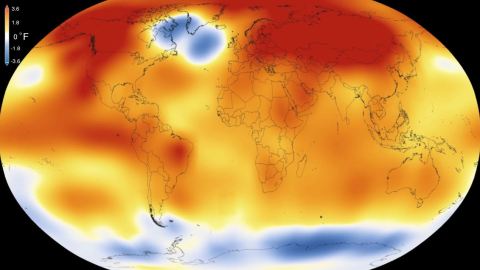Report: Atmospheric CO2 levels hit all-time high in 2017

In 2017, Earth’s atmosphere had higher levels of the main greenhouses gases—carbon dioxide, methane and nitrous oxide—than it’s ever had in the past 800,000 years, according to a new report.
The report, published in the Bulletin of the American Meteorological Society and compiled by 524 scientists working in 65 countries, details how the concentration of carbon dioxide (CO2) in the atmosphere reached 405 million parts per million last year—the highest ever observed in atmospheric measurements or ice core samples. In addition to higher quantity, societies are also pumping CO2 into the atmosphere at rates four times faster than those of the 1960s.
Last year was also the warmest non-El Niño year on record, which is significant because El Niño years typically bring warmer weather. That’s because El Niño is the warmer of the two phases in the El Niño-Southern Oscillation (ENSO) cycle, which describes how temperatures of the Pacific Ocean change based on the behavior of trade winds. The opposite phase of El Niño is La Niña, during which colder weather can be expected.
The report also found that in 2017:
- Arctic land surface temperature was about 2.8 degrees Fahrenheit warmer than the 1981-2010 average.
- Arctic sea ice extent at the end of the growth season saw its lowest maximum in the 37-year satellite record, covering 8% less area than the 1981–2010 average.
- Preliminary data indicate that glaciers across the world lost mass for the 38th consecutive year on record; the declines are remarkably consistent from region to region. Cumulatively since 1980, this loss is equivalent to slicing 22 meters off the top of the average glacier.
- Antarctic sea ice extent remained below average for all of 2017, with record lows during the first four months.
- In the tropics, 2017 saw 85 named tropical storms, slightly above the 1981–2010 average of 82.
- Precipitation over global land areas in 2017 was clearly above the long-term average.
- Across the global oceans, the overall long-term sea surface temperature (SST) warming trend remained strong. Although SST cooled slightly from 2016 to 2017, the last three years produced the three highest annual values observed; these high anomalies have been associated with widespread coral bleaching.
- Global fire activity was the lowest since at least 2003; however, high activity occurred in parts of North America, South America, and Europe.
The findings aren’t encouraging, according to Greg Johnson, an oceanographer at NOAA’s Pacific Marine Environmental Laboratory in Seattle, Washington, during a press call about the report.
He said that even if societies “stopped the greenhouse gasses at their current concentrations today, the atmosphere would still continue to warm for next couple decades to maybe a century.”





